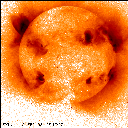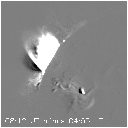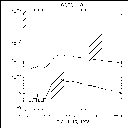

Note incidentally that even though this is a "thin aluminum" image from SXT, recorded almost 6 years after the rupture of the SXT thermal prefilter, almost no trace of stray light is present. In particular the dreaded pinhole brightening at the SE limb has been corrected beautifully.
Why are over-the-limb events interesting? We identify giant arcade events such as this with CME launching, and now have the "dimming" signature (see below) to clarify this point. The flares associated with such coronal restructurings and/or eruptions clearly differ from their more compact counterparts, although the latter frequently show ejecta too - type III bursts, sprays, and even hot plasma sometimes.

This difference image shows a dark region seemingly peeping out from behind the bright flare loops. This is the pre-event structure which disappeared during the flare, no doubt resulting in a spectacular CME. When SOHO is back... this would have been wonderful to observe. In the meanwhile the Mauna Loa observatory was at night. Luckily Nobeyama was observing.
Interestingly enough, there was little hint of meter-wave activity during this major event. We might have expected type II and type IV emission. At the time of writing, no data were available from CGRO - Yohkoh's own hard X-ray instrument was blind during the interesting part of this event because of the poor timing of day and night (orbit night intervals for Yohkoh shown here as hashed regions):

In general, we would surely like to see the non-thermal counterparts of such events, high in the corona.